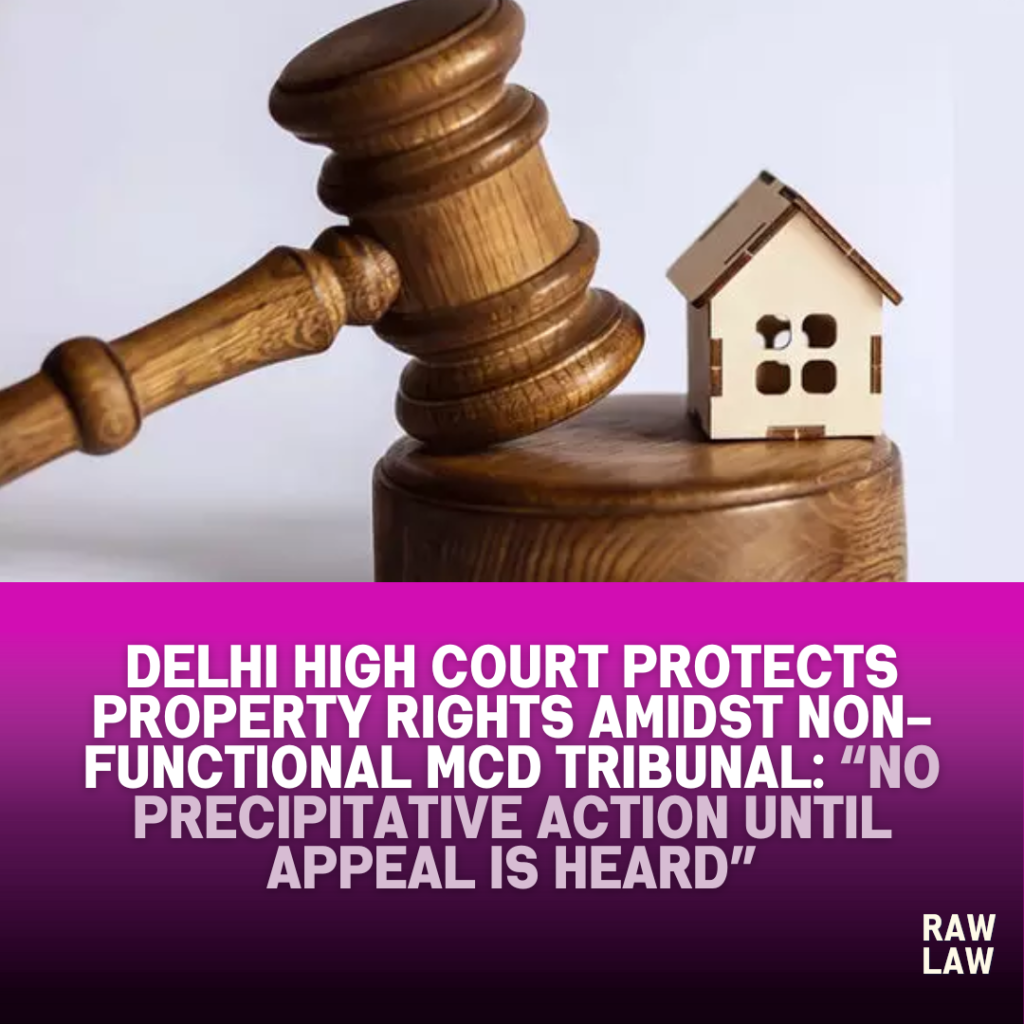Court’s Decision
The Delhi High Court, while exercising its supervisory jurisdiction under Article 227 of the Constitution, directed the Municipal Corporation not to take any coercive or precipitative action against the petitioner’s property until the petitioner’s stay application is decided by the Municipal Corporation Appellate Tribunal. The Court observed that since the Tribunal was non-functional due to the absence of a Presiding Officer, it was imperative to safeguard the petitioner’s rights until the appeal could be effectively heard.
Facts
The petitioner filed an appeal before the Municipal Corporation Appellate Tribunal challenging the threat of demolition proceedings against her property. However, the Tribunal was non-functional as no Presiding Officer had been appointed. On 03.09.2025, the matter was listed, but due to the absence of the Presiding Officer, the Reader adjourned the appeal to 19.09.2025.
Fearing that her property could be demolished before her stay application was considered, the petitioner approached the High Court under Article 227 of the Constitution. She sought protection until her appeal could be heard on merits.
Issues
- Whether the petitioner’s property could be demolished when her appeal before the Appellate Tribunal remained unheard due to non-appointment of the Presiding Officer.
- Whether the High Court, under Article 227, could grant interim protection to ensure that the petitioner’s appeal is not rendered infructuous.
Petitioner’s Arguments
The petitioner contended that in the absence of a functioning Tribunal, her appeal could not be adjudicated. This lacuna exposed her property to imminent demolition by the municipal corporation without affording her an effective hearing. The counsel stressed that such action would violate principles of natural justice and cause irreparable harm to the petitioner’s property rights. Therefore, the Court’s intervention was necessary to prevent prejudice until the Tribunal resumed functioning and considered her stay application.
Respondent’s Arguments
The respondent, appearing on advance intimation, fairly assured the Court that without prejudice to the rights and contentions of either party, no precipitative action would be taken against the subject property until the petitioner’s stay application was heard by the Appellate Tribunal. The respondent emphasized that this assurance safeguarded the petitioner’s interest while also allowing the Tribunal to adjudicate in due course once functional.
Analysis of the Law
The case highlights the importance of the supervisory jurisdiction of High Courts under Article 227, which ensures that citizens are not denied justice due to administrative or institutional delays. When statutory tribunals remain non-functional, litigants cannot be left remediless. Courts, therefore, intervene to protect parties from irreparable harm while respecting the authority of the tribunal to finally adjudicate.
The principle at play is a balance between administrative exigencies and protection of fundamental rights, ensuring that demolition or other irreversible actions are not carried out before an effective remedy is available.
Precedent Analysis
While this order was brief and situational, its reasoning resonates with earlier Supreme Court and High Court jurisprudence:
- Shyam Kishore v. Municipal Corporation of Delhi (1992) – Reinforced the need for fair hearing and balance between revenue collection and taxpayer rights.
- Assistant Collector of Central Excise v. Dunlop India Ltd. (1985) 1 SCC 260 – Stressed that while government requires revenue, courts must prevent coercive action where remedies are pending.
- Whirlpool Corporation v. Registrar of Trademarks (1998) 8 SCC 1 – Reaffirmed that writ jurisdiction lies when alternate remedies are not effective or efficacious.
These cases collectively underscore the principle that courts must step in when statutory forums are unavailable or ineffective, as in the present case.
Court’s Reasoning
The Court reasoned that since the Tribunal was not functional, there was a risk that the petitioner’s property could be demolished without her stay application being heard. Such an outcome would not only violate fairness but also render the appeal infructuous.
Taking into account the assurance from the respondent’s counsel that no precipitative action would be taken, the Court held that it was just and proper to protect the property until the Tribunal could adjudicate the matter. The High Court thus struck a balance between protecting the petitioner’s rights and respecting the jurisdiction of the Tribunal.
Conclusion
The High Court disposed of the petition and pending applications by directing the Municipal Corporation not to take any precipitative action against the petitioner’s property until her stay application is heard by the Municipal Corporation Appellate Tribunal. This ensures that the petitioner’s appeal remains effective and her property rights are safeguarded in the interim.
Implications
This order underscores the judiciary’s role in bridging gaps caused by administrative delays. It reassures citizens that their rights will not be prejudiced due to the absence of functioning statutory forums. For municipal matters, it sets a precedent that demolition or coercive actions should not be taken when appeals are pending but unheard for no fault of the appellant.
The decision also reflects a larger theme: access to justice must remain meaningful, and institutional vacancies cannot become a reason for denying citizens’ remedies.
FAQs
Q1: Can property be demolished if an appeal is pending but the Tribunal is non-functional?
No. Courts can step in to protect property rights until the Tribunal resumes functioning to hear the appeal.
Q2: What power does the High Court have under Article 227 in such cases?
The High Court supervises tribunals and lower courts to ensure justice is not denied due to procedural or administrative delays.
Q3: Does the Court’s order decide the merits of the case?
No. The order only grants interim protection; the merits of the appeal will be decided by the Appellate Tribunal once functional.



